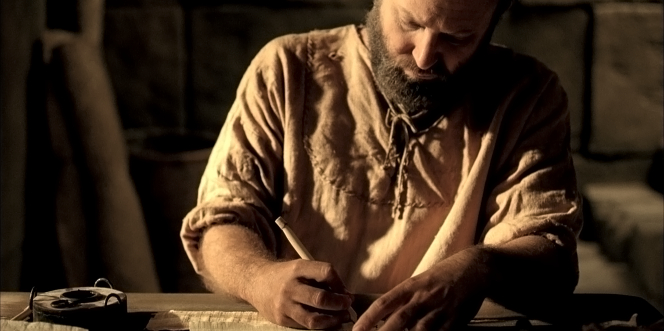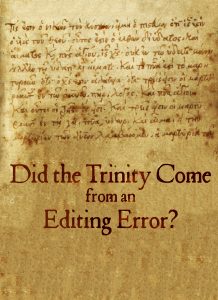Did the Trinity Come from an Editing Mistake?
The belief in a Godhead, as opposed to a Trinity, is one fundamental doctrine which sets Latter-day Saints apart. We believe in a Heavenly Father and a Savior Jesus Christ. We believe that these two are beings with glorified corporeal bodies, and that a third member of their Godhead, the Holy Ghost, is unified with them, to be one in purpose rather than substance.
Modern day revelation makes clear the nature of the Godhead. So where did the idea of the Trinity come from? Some Biblical verses have been interpreted to mean that God is one in substance. But the history of one significant verse in this understanding may shed light on how this idea developed.
The Comma Johanneum

Erasmus of Formia was obsessed about the Bible to the point where he started to create his own editions of it (as was popular among the religious holy men of his day). However, in one of his manuscripts he failed to include 1 John 5:7-8, which are very important to the Trinitarian argument, which became a solid doctrinal tenet after the Council of Nicea in 325 A.D. [quote_box_center]7 For there are three that bear record in heaven, the Father, the Word, and the Holy Ghost: and these three are one.
8 And there are three that bear witness in earth, the Spirit, and the water, and the blood: and these three agree in one.[/quote_box_center]Those two verses are what is called the Comma Johanneum or, in other words “Heavenly Witnesses.” Supposedly, it is a Latin corruption within the Greek manuscript of the Bible.
The earliest Greek manuscripts that Erasmus had studied did not contain the text, and so he saw it as a corruption. Therefore, he refused to add it into one of his editions unless a Greek edition that predated the ones that he had studied could be found that contained it. With doctrine on the line, one such manuscript was procured, and he added it to his next edition.
That edition was written for two reasons.
- To include the Comma in order to promote Trinitarian theology.
- To come out before a competing translation that was in the works: the Complutensian Polygot
The Polyglot was to be the best translated version of the Bible that had ever been. In fact, most of the King James Version was based off of its translations. Erasmus’ fourth edition was as well and ended up being a standard text for two hundred years.
Nevertheless, the Comma must be put into question. Yes, it might be possible that the Trinitarians of his day were able to come up with a Greek text with the Comma intact, proving it’s originality. But how do we face a key belief such as this, concerning who our God is, when it has such an unstable foundation (how it ended up in our Bible today)?
Unstable Foundation of the Bible

“We believe the Bible to be the word of God as far as it is translated correctly.”― Article of Faith #8
It can’t be questioned that the Bible lacks complete solidarity, and there are multiple reasons for this.
- Most of the original texts are not around today.
- Multiple translations read differently, giving different meanings.
- Translations of the Bible were subject to the politics of their day.
- Hundreds of thousands of textual changes have occurred throughout the history of the Bible’s translations, twisting meanings through punctuation and wording.
- The Bible is a collection of ancient stories and letters where some have been added or taken out. For example, the famous story of Jesus and the woman taken in adultery (John 8) did not appear in any manuscript until the late 4th or early 5th century, and it is uncertain whether or not it is a true account or religious fiction (by the way, this story is referred to as the Pericope Adulterium).
With the Comma Johanneum in question, we do not have the very first copy of 1 John to prove whether or not it is really an addition or if certain editions simply neglected to add it. We also know that the nature of God was argued among early Christians because it was an issue enough that the First Council of Nicaea in 325 A.D. produced a creed stating that God, Jesus Christ, and the Holy Ghost were one substance. This council of bishops was full of contention.
Also, with governmental papal authority on the rise starting in 380 A.D., political manipulation of text became more common. Yet, despite all of the faults that we could ever find in the Bible, we must acknowledge that none of these are of God. They are of men. Knowing this shouldn’t diminish your testimony, but, if anything, it should strengthen it.
In the last 2000 years, with imperfect men at the helm of the writing of His word, many truths in the Bible have been very well preserved. [quote_box_center]”We should be appreciative of the great spiritual heritage and source of inspiration that has come to us through the Bible, yet readers the world over have recognized for many years that the Bible has not come to us in its original purity and plainness.”― Robert J. Matthews (Assistant Professor of Ancient Scripture at Brigham Young University)[/quote_box_center]Even more, we have modern revelation and the restored Gospel to be grateful for the preservation of such truths, despite mankind’s intentional and unintentional corruption of the Bible. As we read it and compare it to The Book of Mormon and the words of our prophet and apostles today, we will gain a deeper understanding and testimony of the Godhead.[quote_box_center]”When it is read reverently and prayerfully, the Holy Bible becomes a priceless volume, converting the soul to righteousness. Principle among it’s virtues is the declaration that Jesus is the Christ, the Son of God, through whom eternal salvation may come to all”― The First Presidency (Ensign, May 1983)[/quote_box_center]
Who are God, Jesus Christ, and the Holy Ghost?

In Genesis 1:26 we learn that He even created man and said “Let us make man in our image.” Here, we learn something else about that process. The words “us” and “our” refer to a plurality, another individual. He was speaking to Jesus Christ. The Pearl of Great Price clarifies this:[quote_box_center]”And I , God, said unto mine Only Begotten, which was with me from the beginning: Let us make man in our image, after our likeness….And I, God, created man in mine own image, in the image of mine Only Begotten created I him; male and female created I them.” (Moses 2:26-27)[/quote_box_center]Of that beginning, Jesus Christ said, “I was in the beginning with the Father, and am the Firstborn” (Doctrine and Covenants 93:21). At the Father’s will, He created us and the world.
“The worlds were made by him; men were made by him; all things were made by him, and through him, and of him” (Doctrine and Covenants 93:10).
During the Creation, whenever God said “Let there be” light, darkness, water, grass, and creatures “it was so” because of the obedience of Jesus Christ to Him and the perfect unity that the two have.
One of the biggest contributors to the unity that Christ and Heavenly Father has is the Holy Ghost. The Holy Ghost testifies of all that is good, and all that is good comes from God (see James 1:17). Furthermore, one of the Spirit’s purposes is to testify of Christ (John 15:26).
The Companionship Godhead According to John

On a personal note, I love The Gospel According to John. It testifies clearly of their separate personas, existing together like a unified missionary companionship: two separate individuals who never leave each other and testify of the other.[quote_box_center]”16. For I am not alone, but I and the Father that sent me.
17. It is also written in your law, that the testimony of two men is true.
18. I am one that bear witness of myself, and the Father that sent me beareth witness of me” (John 8:16-18).[/quote_box_center]However, they weren’t just a dual companionship. The Godhead is more like a missionary trio (three companions) because when Christ said “There is another that beareth witness of me” (John 5:32), He is referring to the Holy Ghost.
In the mission field, if one companion stays in bed all day or refuses to talk during lessons, then true missionary work doesn’t happen. The companionship cannot function, because you can’t preach the gospel on your own without a companion. That is why Christ sent missionaries out “two and two” out into the world (Luke 10:1).
Likewise, the same goes for the Godhead. They do not work alone.
“I can of mine own self do nothing…because I seek not mine own will, but the will of the Father which hath sent me” (John 5:30).
One of the most miraculous and beautiful aspects of the Godhead is the fact that they are separate individuals. Yet, they are so connected and have such a deep respect for each other that they have an unbreakable unity, standing by one another eternally and serving as one.
“I and my Father are one” (John 10:30)
 Whether or not the Comma Johanneum was a corruption has little importance. Although it is key verse in the Trinitarian argument, it still allows for a Godhead argument and a strong one at that. It speaks of a plain and simple truth concerning Heavenly Father, Jesus Christ, and the Holy Ghost: the unity or oneness of three separate beings.
Whether or not the Comma Johanneum was a corruption has little importance. Although it is key verse in the Trinitarian argument, it still allows for a Godhead argument and a strong one at that. It speaks of a plain and simple truth concerning Heavenly Father, Jesus Christ, and the Holy Ghost: the unity or oneness of three separate beings.
Throughout the New Testament we are told that in order for us to truly know God that we must come to know Jesus Christ. Think about one thing that you can do to come to know the Savior more and seek the guidance of the Holy Ghost on it. I promise that as you go about doing that very thing that you will come to know your Heavenly Father more and develop in your relationship with Him.


